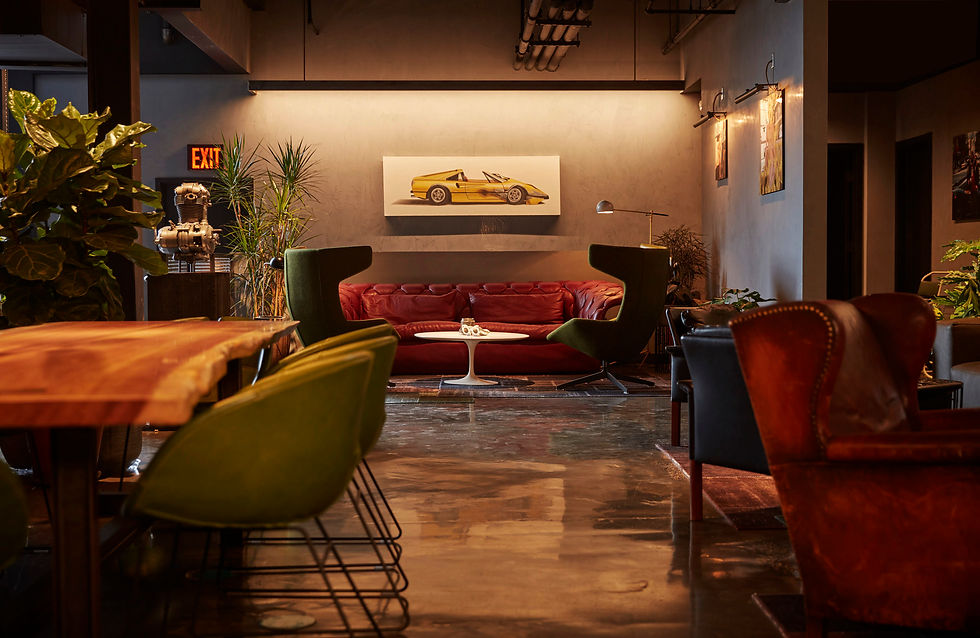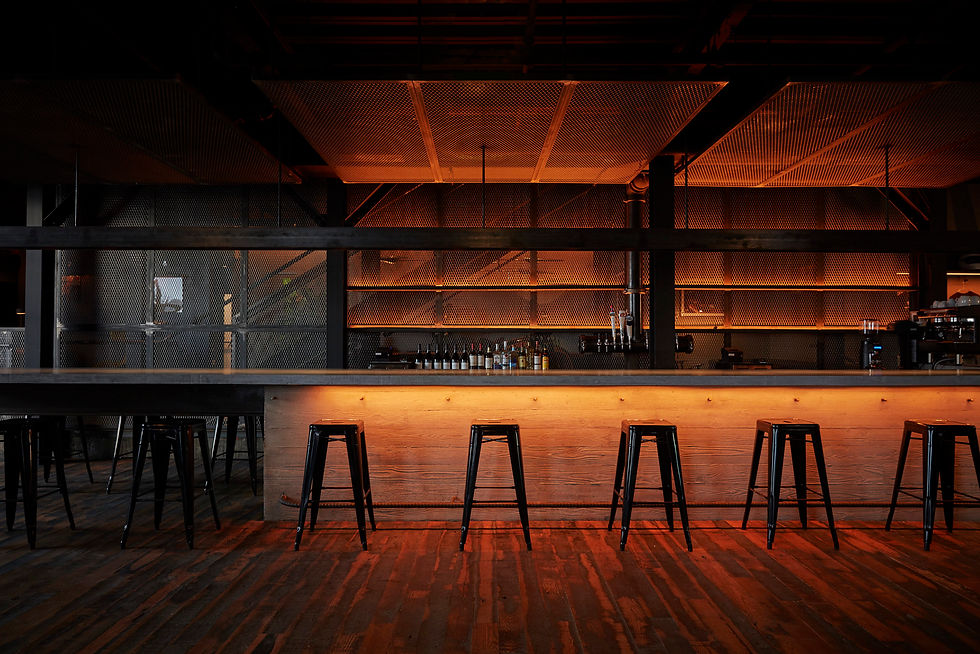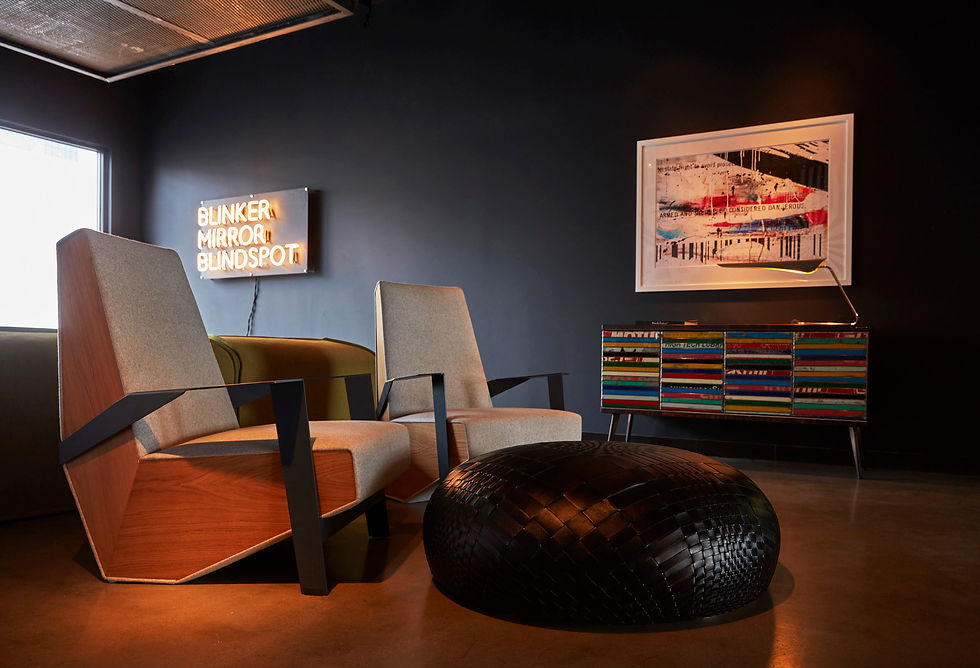A Conversation with Mike Prichinello, the Creative Director of NYC's Classic Car Club
- Staff
- Apr 15, 2019
- 10 min read
Updated: Oct 25, 2024
by #LizPublika

Delectable steak tartare is being prepared by a heavily tattooed chef at one of the most sophisticated and yet laid back kitchens in New York City. Whether you take the meal on the 3,200 square foot terrace on the Hudson that’s sparingly decorated with stunning vintage cars, or inside the striking restaurant adorned with muted but thoughtful auto-inspired decor is really up to you. As a member of the Classic Car Club, you have the pleasure and the privilege of being catered to in whichever setting is most appealing to you.

Mike Prichinello, the creative director of the Classic Car Club, made sure that the immersive environment of the city’s most reputable auto-establishment is a recreational paradise for both risk and adventure seekers as well as refined classic-automobile connoisseurs. As a well-known PR strategist and one of three founders of the Classic Car Club, Prichinello is skilled at using design, art, and luxury branding to make anyone feel like a valued member of the exclusive institution.
Although he came from four generations of Brooklynites, Prichinello was raised in Massapequa Park, Long Island. His parents encouraged him to get the best education possible and to get involved in as many school activities as he could handle. “They raised me to be successful, and their version of success was based on very traditional tropes. I was just never wired like that, that never interested me.” Prichinello was not a budding scientist or a future surgeon; he was a skateboarder with a passion for thrills, speed, and competition.
“It’s funny,” he muses, “I guess having parents from Brooklyn, driving and cars were never a part of any of my family culture.” Unlike his mom and dad, though, Prichinello “had this real interest in cars.” After obtaining his license, he dreamt of getting a 1968 Chevelle, “which is not the car to get when you’re 16.” His dad, believing that it was not an appropriate vehicle for the inspired teenager, ultimately swayed him to get a more standard alternative, but not before agreeing to send his son to racing school.
After graduating from Fordham University, the risk-seeking young man aspired to join the FBI. “It’s an adrenaline junkie job, right?” reasoned Prichinello. “At least I thought it was. I’m not in the FBI because I learned it’s a lot of paperwork.” Realizing that the career choice was not actually in line with his nature, he switched gears and joined the RLM Public Relations firm. Creative, imaginative, and full of energy, he quickly rose to become one of the company’s most successful members, even co-authoring a book about PR for Bloomberg press.

But, being a man who likes to march to the beat of his own drum, Prichinello soon founded his own marketing company, which eventually became well-known for elevating men’s luxury brands. Then, one day, he got a phone call that changed his life. Simon Williams, owner of Sterling Brands, introduced Prichinello to a British man by the name of Phil Kavanagh, who wanted to bring his business venture to the US market. The venture, as it turned out, was the “embryonic version” of what would soon become Manhattan's Classic Car Club.
“When I met Phil, I was like, ‘Yeah, let’s work on this!’” he recalls. “I was going to do all the marketing and stuff, but I also saw something that I really wanted to get involved with.” Around the same time, on a serendipitous flight from London to New York, a lighting designer by the name of Zac Moseley had watched a documentary about the British Classic Car Club. When he landed at the airport, he whipped out his phone and called the company, expressing interest in creating an offshoot of the club in the Big Apple.

One thing led to another and the Classic Car Club was launched in 2005. ARTpublika Magazine had the pleasure of speaking to Mike Prichinello about his love of cars, marketing, and the creative direction behind one of the city’s most notorious auto-establishments.
Did you hope to continue the legacy of the original Car Club that launched in London in 1995?
When we started this, Zac and I had never been to the club in London. We went there a little after it all.
The Classic Car Club has three owners. What are your roles?
I’m the creative director guy here. Phil handles the finances, and Zac handles the day to day operations and paperwork. Together, we’re a really good team.
How did the venture evolve from a driver's club into a cultural hub?

So, we used to be at 250 Hudson Street; it was 9,400 square feet of space. Now, at Pier 76, our space is 40,000 square feet, which is a really big upgrade.
But, when we were at the old space, I was like, “If we’re going to have members here, why won’t we make it inviting? Why don’t we build a lounge? And, let’s have a bar here!” The other thing I thought was, “Why not treat everyone like adults and give members a security card, so that they could open the door to the Car Club 24/7?” Members can’t take the cars out if we aren’t there, but they could hang out. And those two things together — the 24 hour access to the club and the bar — create a real culture at the car club.

Now, at our new space, we have a full bar, restaurant, lounge; we have about 10,000 square feet of club space, a 4,000 square foot terrace on the river, and we do programing here —scotch tastings; this thing we call femme fatale, where we try to feature a really rad woman in motorsports; auto and motorcycle race teams; etc. Driving a car, that’s just one of the many elements.
How do you choose the cars that you feature in your fleet?
So, I think we have about 38 cars right now. Since 2005, we’ve had about 390 — all very cool, special cars. [The Classic Car Club’s] definition of classics is anything that progresses the arc of automotive power. So, we have classics and modern classics as well.

We started with 17 cars. The way we chose them was Zac and I made a list of all the car posters we’ve had on our walls as kids, then we went out and bought all of them. It wasn’t scientific, but it was a hell of a lot of fun. But now, it’s more of a debate; I’d say about three hours per week are spent on just debating what kinds of cars we’re going to get.
I don’t like to buy what people want right now. I always try to find what people are going to want in a few years. Like, at the moment, I am really into buying American made cars that were never meant for the American market; there’s a 25-year rule for importing certain kinds of cars from other countries. But, I like to make sure that our fleet is informing people about what they should be looking at next; to take people out of what they’re accustomed to and get them to try new things. These cars are escape pods — to me, they are a gateway to an adventure.

What kinds of memberships do you have?
Because we had created this culture and community back at our old location, a lot of people wanted to be involved in the club but not actually drive the cars. (Our members tend to be kings of their own universes; many of them have 50 cars of their own.) Anyway, I didn’t feel like the limited space that we had allowed us make a product for them that we could be proud of. So, before we moved, we made sure we found a space that would suit those people, too. Now, the two memberships that we have are the driver’s membership and the clubhouse membership.
All of our members pay their monthly dues, which are $180 per month, but drivers also buy their package of points. Basically, we have the cars set up in bands, and each band is determined by the expense of the cars and the expense to maintain them. Drivers can drive all the cars in the fleet whenever they want, as well as participate in all of our international rallies, compete in our race teams, and take part in all the events that we do.

Clubhouse members can still drive the cars, but they are limited to group events. So, for example, we’ll take out 12 people on six cars — all supercars or something else — and let them drive on a really beautiful and technical road in the mountains. Since we also do international rallies and races, clubhouse members can join us on those, too, they just can’t call on a Wednesday and say they’re going to take the McLaren for a couple of days during the week. Their diving is limited to the groups.
What is your membership demographic?
The goal for me is to bring more people into the club — bring more women into the club. Our driving demographic is 20% female and 80% male, between 35 and 45 years old.
Your restaurant is run by Chef Jesse Ford.
Yes.
Was he also a racer?

Yes. Not only is his last name Ford, he has a number of [car-inspired] tattoos — a Cadillac logo, a Chevy logo, and last month he got a Lamborghini on his arm — and was what’s known as a monkey. In sidecar motorcycle racing, the most insane motorsport there is, the monkey is the guy in the sidecar. That was Jesse, but he’s also a classically trained chef; his food is extraordinary, extraordinary! Our members’ standards are high and our club’s standards are high. The culinary arts are a really big part of this place.
Your new space was designed by Mark Thorpe?
Yeah. Mark Thorpe is a long-time member of the Classic Car Club and he even designed our little 400 square foot lounge in the old space. And so we hired Mark to design the new space, too. He’s a real super modern minimalist and his style matches us, since we’re cold hard material. So Zac and I collaborated with him on the design here.

I’m pretty certain — Zac and I say this all the time — we were either his best clients of all time or we were his absolute worst. I’m not sure, but it came out really good. Mark did the physical layout and designed the bar and the restaurant. I worked with Mark on the furniture and brought in designers from Italy that I know and really like. Then, the space was filled with artwork and stuff, so I tried to bring in the culture of what we’re doing to the surface through the art and the design.
It’s interesting that you also incorporated a gallery into the space, what inspired this idea?
Car culture, as a whole, has real shit aesthetics — checkerboard flags are cliche. I have this beautiful room full of these outstanding cars, so I don’t need obtuse car references everywhere. [Instead,] I try to curate art that’s reflective of what we are doing but isn’t so obvious.

We have a lounge upstairs — I think the wall is 70 feet long — so I wanted to put a mural up there. I thought about street art that I know, love, and admire, and then I started researching other art and artists. I picked this team — a woman named Geraluz and and a guy named W3rc, who is her collaborator and partner in life. They’re both Peruvian, live in Brooklyn, and do these beautiful murals on a very large scale.
We’ve been using the dazzle-ship design for years and it’s become kind of iconic for us. So they did their reiteration of the dazzle-ship on our wall to reflect back on the club a little bit. And since our space used to be a horse stable, they worked in some horse scenes — like where the horse turns into the driver cockpit of a Ferrari, and of Freddie Spencer whose motorcycle is part horse and part vehicle. It sounds really weird but it is lovely.
But the artistic elements are found everywhere at the Classic Car Club.
There are also these two dudes from Italy, they’re called Vibrazioni Art-design and they’re a bit like Daft Punk — you always see them with their welder masks on but you never really see their faces. But their art is exclusively based on oil barrels. [In America, oil barrels are bland and boring,] but in Europe these barrels are really branded up. So, for example, Petronas — which is an oil company — sponsors the Mercedes Formula One Team.

So, the guys used to build custom motorcycles with the barrel material, and then they started doing furniture with it, and the furniture is great. Upstairs, I had them do a credenza for us, a coffee table, our bar stools, and lamps. Their work is so highly automotive, but you wouldn’t know it, you know what I mean? And, all of our furniture is by Moroso, a very famous modern Italian design shop.
I also have artwork from a guy named Steve Ellis who does sort of like real pop culture Americana things. I have one huge oil painting from him, which I’m really proud of, and it’s of a bunch of ripped up tankers, with each one being a car reference. Then, in one section, we have his Crashed Ferrari Modena that he painted in 2004.
You guys also have these amazing racing simulators, don’t you?

Yeah, we do. They are the most sophisticated simulators in America. Motion Simulation, the UK company that makes them, is very focused on the software and the technology, so these pods are about $80,000 a piece, and we have three of them. [Racing on the simulators] is exactly like racing in real life. We have about 50 cars on the simulator and many tracks from around the world. They are about as accurate as they could be, so before I go to race, I’m in the simulator learning everything about that track, and my time on the simulator turns out to be very similar to that in real life. We’re going to start a synthetic racing academy, where we’ll teach you how to be a proficient driver before you ever get to a race car. We give our members keys to cars that can f***ing kill them, so if I can increase their acumen in the sim room — everyone benefits.
Are you working on anything new at the moment?
I’m actually working on an album right now. First, I recorded all of the sounds that four of our cars make — from light switches to engine noise to seat belt clicks. Then DJ Karl Marx, a very prolific DJ I’m collaborating with, made a track for each car using its sounds. This rapper from Queens named Meyhem Lauren is doing the lyrics. We’re probably going to release the record in June. The cars I used were Porsche 911 GT3 , Acura NSX, Lamborghini, and Corvette.
Note* All of the images were courtesy of the Classic Car Club
